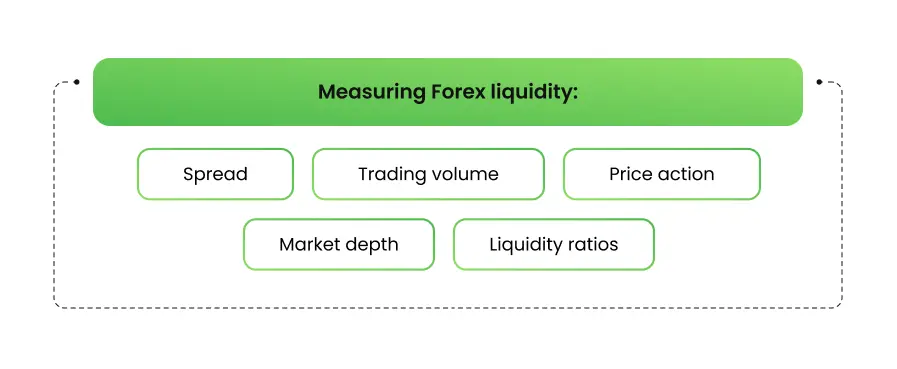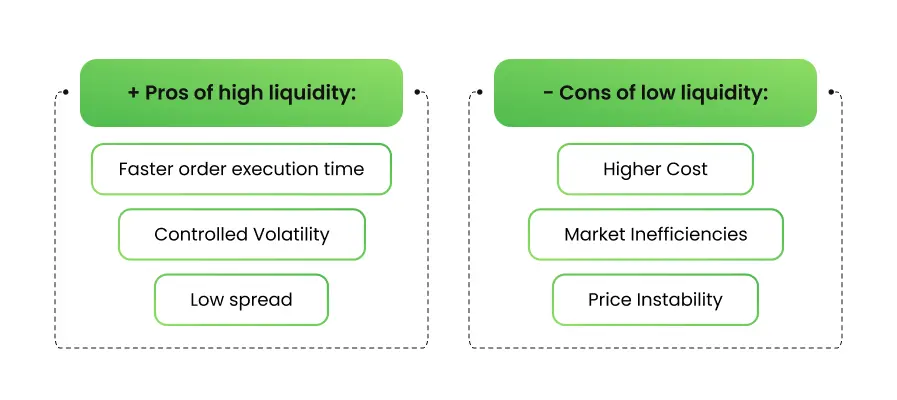Why Does Forex Liquidity Matter, and How Do You Measure it?
- Introduction
- What is liquidity in Forex?
- Importance of liquidity
- Forex market overview
- Factors affecting Forex liquidity
- Measuring Forex liquidity
- Final thoughts
- FAQs
Introduction
The foreign exchange (forex) market is the largest and most liquid global financial market trading trillions of dollars worth of different currencies every day. For most people, it is a sort of decentralized network of participants trading various pairs of currencies with the pricing being controlled by the forces of demand and supply. However, the participants of a forex market go beyond just individuals, it consists of banks and other financial institutions too. This powerful global market is being powered by a very important element — liquidity.
What is liquidity in Forex?
Liquidity can be easily explained as the availability of something, preferably a resource. In the context of foreign exchange markets, liquidity refers to the ease and efficiency with which a currency pair in the market can be easily sold or bought without significantly affecting the price. It refers to the readily available demand and supply for a currency pair, that is, the currencies are readily available and sufficient traders are willing to trade them.
Liquidity is the lifeblood of the forex market. Due to the nature of the forex market— volume of participants and providers, it is important that transactions are settled quickly at a price closest to the real market value. That is where the importance of liquidity comes in.
Markets with high liquidity are very efficient. The orders are executed seamlessly and quickly at a price close to market value ensuring a low spread range and minimum slippage. Markets with low liquidity on the other hand will suffer long pending orders at rates differing from the regular rates. This is because there is a shortage in demand for the pair and there are fewer buyers than normal.
Importance of liquidity
As mentioned earlier, Liquidity is very important in the forex market. It helps to maintain the balance and stability of the market. It does this by:
- Ensuring fast execution. Highly liquid Markets will enjoy speedy order execution with very little slippage (i.e. the difference between the desired price and the executed price).
- Reduced Volatility. Markets backed up by sufficient liquidity will experience less volatile price swings. This ensures a stable price market and minimal investor losses.
- Tighter Spreads. A spread is the gap between the buy and sell prices of currency pairs. High liquidity reduces the spread and ensures lower transaction costs. Overall, this results in fair pricing for market participants.
Forex market overview
The global forex market is estimated to have a daily volume of $2.4 quadrillion, making us a highly liquid market. This huge forex market consists of a large range of diverse participants. These participants are responsible for the constant demand and supply of forex ensuring a reliable pool of liquidity for trades in the market. Some of these participants are:
- Central Banks. These are some of the biggest participants in the market in terms of volume. The central banks of various countries are responsible for managing their national currencies and influencing the exchange rates of their currency against others.
- Financial Institutions. Many financial in St are directly involved in the forex market. Institutions like banks, investment firms, and brokerages often act as intermediaries on behalf of their clients to facilitate forex transactions and provide market access.
- Speculators and Hedgers. This group of individuals, businesses, and traders aim to either gain profit from foreign exchange fluctuations or mitigate the forex liquidity risks associated with international transactions.
Factors affecting Forex liquidity
The forex market plays a very significant role in international trade and globalization. Any slight price fluctuation in the forex market can significantly influence trade agreements between countries and global investment. The liquidity of the forex market is not exactly constant, although it has a baseline level of liquidity. Understanding the factors that affect liquidity can help traders anticipate changes in the FX market and adjust their trading strategies.
Some of the factors influencing Forex liquidity are:
- Market Size. Market size is one of the most important factors that affect forex liquidity. Popular currencies like the US Dollars (USD), Euro (EUR), and Japanese Yen (JPY) have high liquidity due to their high volume and global demand.
- Monetary Policies. Monetary policies and interventions enacted by the central banks usually have a significant effect on the FX market. They can influence investors and market sentiment and consequently affect the liquidity levels of such currencies.
- Global News and Events. Important news and events like political decisions, economic news and events, and natural disasters also significantly influence market sentiment. This can then affect liquidity by encouraging or discouraging trading activity on some currencies.
- Trading hours. There are some specific trading hours or sessions adopted by major financial trading centers ( New York, London, Tokyo, etc.). Trading during trading hours guarantees liquidity. However, liquidity may be reduced significantly for traders trading outside these hours.
Measuring Forex liquidity
Measuring forex liquidity can be a little bit technical, it is not exactly like counting how much money is in the market. However, there are a few metrics that can be used to measure a currency’s liquidity.
- Spread. The Forex market is quite similar to other markets. Like others, the currencies have different buying and selling prices. The market makers buy currencies at a price and then sell for higher prices. Consequently, brokers offer different buy and sell prices and traders buy currencies at a price higher than the selling price. The gap between this buying price and the selling price is called a spread. A tight spread indicates high liquidity, more competition, and tighter pricing.
- Trading volume. The trading volume refers to how many active transactions or exchanges occur between buyers and sellers. High trading volume is associated with high liquidity while low trading volume is associated with low liquidity. Traders often compare the historic and present trading volumes of trade currency pairs to find out the change in liquidity levels in a market.
- Price action. Price action is also a good measure of liquidity. A stable market with consistent pricing signifies an adequately liquid market. Currency pairs or markets with high price volatility are less liquid.
- Market depth. The market depth refers to the number of placed orders in a market, usually the pending buy and sell orders in the market. When there are many orders placed, it signifies many traders in the market and of course high liquidity. Traders often analyze the market order book and measure its depth to gather insights into the liquidity of the market.
- Liquidity ratios. Liquidity ratios are popular metrics for measuring liquidity. Turnover ratios in particular (e.g. current ratios, quick ratios, cash ratios) are used to measure liquidity.

Final thoughts
It is important to establish at this point that high liquidity is very advantageous to the forex market and low liquidity is bad for the forex market. Let’s now analyze the pros of a market having high liquidity and the cons of having low liquidity.
Pros of high liquidity.
- Faster order execution time. High liquidity is often an indication of many orders and traders. Therefore, the higher the liquidity, the higher the likelihood of a speedy trade execution.
- Controlled Volatility. High liquidity is heavily associated with stable markets with very low price volatility. This ensures consistent pricing and trader risk minimization.
- Low spread. The more liquidity in a market, the lower the gap between the ask and bid prices.
Cons of low liquidity.
- Higher Cost. When there is a low supply of liquidity in the market, prices go higher. Consequently, the spread and the transaction costs are higher too.
- Market Inefficiencies. Due to low market liquidity, the market orders execution time will get longer, delaying execution and increasing cost. The market inefficiency can then become unattractive to potential traders.
- Price Instability. When there is low supply in the market, traders become more sentimental and sensitive to market news which can cause prices to become unstable.

The Forex Broker Turnkey solution includes all the key components required for effective risk management in Forex brokerage firms, including a smart liquidity aggregator.
FAQs
Q1: What do liquidity providers do in Forex trading?
Liquidity providers are institutions and individuals that quote the buy and sell prices for currency pairs. They help to ensure market efficiency by constantly providing bid-ask quotes. They ensure offers are always available for traders and as a reward for their contribution, they earn a spread.
Q2: Which Forex trading pair has the most liquidity?
Major exotic currency pairs in the global forex market are the most liquid. Some of these major currency pairs are EUR/USD, USD/JPY, GBP/USD, and USD/CHF.
Q3: Why is Forex market so liquid?
Some of the factors that contribute to high Forex liquidity are the large market size, the decentralized structure, the participation of major players, and the market accessibility.
Our team is ready to provide a detailed advice list on the basics of Forex broker risk management with the help of Soft-FX technologies.



